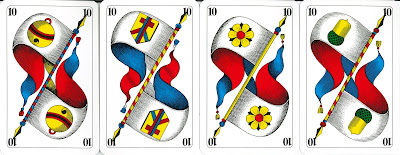01-027
Swiss-suited Playing Cards
After talking about the
French-suited, the Spanish-suited, the German-suited and the Italian-suited
playing cards, today, I am moving onto the fifth and also the final standard
playing card deck that are still commonly used in Europe. It is the
Swiss-suited playing cards.
Swiss-suited playing cards are playing
cards that commonly played in Switzerland. But similar to the situation of
Italian-suited playing cards, only less than half of the Switzerland is using
this card deck, being mainly in the parts where Swiss German is spoken. The
other parts of Switzerland have adopted the French deck.
Swiss-suited playing cards are
very similar to German-suited counterparts. One of the difference is the suit.
In the German deck, the suits are Hearts, Bells, Acorns & Leaves. In the
Swiss deck, the suits are Bells, Shields, Roses & Acorns. Both acorn and
bells are suits also found in German decks, while shields and roses are unique
to Switzerland.
The other major difference is
the inclusion of the “Banner card”. In German, banner means flag. The Banner
card is equivalent to a 10, being ranked between a 9 and an Unter (or Under in
Swiss German).
Swiss-suited playing cards are
normally used for playing Jass, the national card game of Switzerland. And
because of this purpose, the deck is normally stripped to 36 cards only, with 2s
to 5s removed. Some printers do include more cards in the deck, though.
Face-cards are, in Swiss German,
Under, Ober and König. Their sequence depicts social stratification. The Under
characters are working class, depicted as a fool or jester (Bells), a messenger
or scribe (Shields), a peasant (Roses) and a soldier or page/servant (Acorns).
The Ober characters are shown as clerks or overseers/officers, while the kings
are crowned monarchs (three of them seated, the king of Roses is shown
standing).
Swiss-suited playing cards are standard decks and there are no instructions inside the box. In fact, my deck does not even have a box! Technically, Jass can be played with a standard 52-card deck. But using an Swiss deck to play Jass can make the game “Swiss-er”.
General Information
|
Player |
3 to 4 |
|
Playing Time |
45 mins |
|
Age |
8+ |
|
Year Released |
1796 |
|
Designer |
(Public Domain) |
|
Publisher |
AGMüller |
|
Family |
Trick-taking |
|
Score |
7.0 (Board Game Geek) |
Specifications
|
Card size |
Not specific, down to the
printer. |
|
Deck size |
36 cards (normally), 48 cards
(special) |
|
# of suits |
4 – Bells, Shields, Roses
& Acorns |
|
Details |
For each suit, pip cards are
valued from 1, then 6 to 9, then followed by the Banner card (10) and the court
cards Under, Ober and König. |
The game Play
Where
to buy?
swisshouse-shop.com
Swiss-suited playing cards is
the most difficult card deck to find. I have searched all over the internet,
browsing through the websites of all those major card sellers but cannot find
anyone selling this.
But to my surprise, just weeks
before Christmas, I found the Holy Grail! A local Swiss merchandiser is selling
this in Hongkong at just around USD $6. They allow pickup by person, so I even
saved the postage charge. However, a minimum purchase of HKD 380 is required.
As it was Christmas time, I just bought a bottle of Swiss wine for my wife.
The shop is run by an old Swiss guy. It is a small business. The office is hiding inside an old commercial building. He was surprised when learning that I was actually more interested in the card than the wine.
How’s the wine?
Excellent! But I still like the cards more.
Go back to the Lobby ...






















